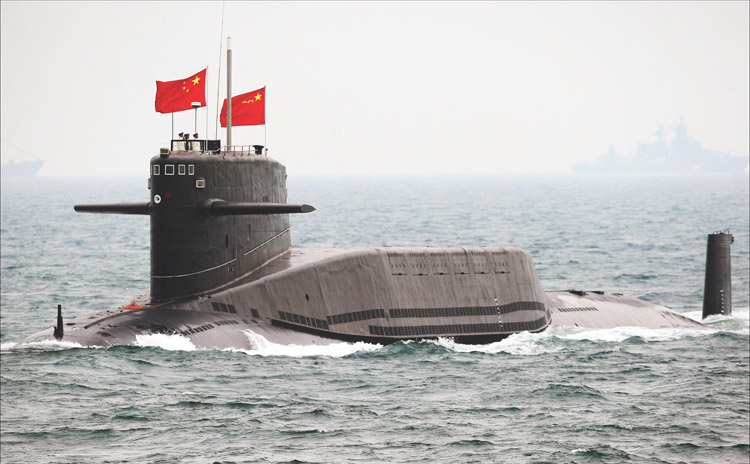Layers upon Layers
 Adm. Arun Prakash (retd)
Adm. Arun Prakash (retd)
Recent reports that ‘Chinese submarines’ had been detected in the Indian Ocean caused a transient flutter in the Indian media but, typically, there was lack of clarity about the source as well as veracity of the reports. One TV channel claimed to have ‘exclusive access’ to a report received by the ministry of defence (MoD) drawing attention to ‘22 unknown submarine contacts’ that were, apparently, detected by Indian Navy (IN) and US Navy (USN) units in the Indian Ocean.
Sources were quoted to provide a geographical breakdown, indicating that six of these submarine contacts were picked up north-west of the Straits of Malacca (i.e. in the vicinity of the Andaman and Nicobar Islands), 13 of them off Dondra Head (south of Sri Lanka) and two as far away as the Arabian Sea. Indian and US intelligence sources were reported, by the media, to have confirmed the origin of these putative submarines as Chinese since it was the only ‘other navy’ that could operate in these areas. While discussing these reports, there is need to remind the reader of two important facts, at the outset.
Firstly, the UN Convention for Law of the Seas (UNCLOS) permits unfettered freedom of navigation on the high seas, and a foreign warship or submarine has as much right to be in the Bay of Bengal as a similar Indian vessel would in the South China Sea. Even in territorial seas, i.e. waters regarded as sovereign territory of a State, there exists the right of ‘innocent passage’ for all vessels. Passage is ‘innocent’ so long as it is not prejudicial to the peace, good order or security of the coastal State. Acts that may vitiate innocent passage include the use of weapons, operation of aircraft, undertaking research or survey activities, and causing pollution. In the case of submarines, while passing through territorial waters they are required to navigate on the surface and to show their national flag; otherwise, they are free to remain submerged.
Secondly, there are currently, four ‘other navies’ in our very close neighbourhood which operate submarines; those of Indonesia, Malaysia, Singapore and Pakistan. The submarines belonging to these navies can, and perhaps do, undertake exercises in waters around India.
Reports of this nature, especially when delivered in the form of ‘breaking news’, are likely to cause concern and create misperceptions amongst, not just the general public but also, India’s politico-bureaucratic establishment, whose grasp of national security issues remains somewhat fuzzy. It would, therefore, be useful to examine a few aspects of China’s maritime power in a larger frame of reference. Such an examination may help evaluate the accuracy of reports regarding PLA Navy (PLAN) submarines lurking in waters around the Indian peninsula, and how much excitement such an event warrants.

PLAN Missions
The PLAN task-groups that have been operating on anti-piracy duties in the Gulf of Aden since 2008 have provided adequate proof that this navy has made rapid strides towards attaining a ‘blue-water’ status. This implies that the PLAN now possesses reliable, multi-role, modern warships, has accumulated adequate professional expertise and possesses the ability to sustain forces at long distances from home for protracted periods. The establishment of logistic arrangements with countries in the vicinity and the use of space-based command and control have obviously helped in the success of these operations. A major spin-off from this deployment, for the PLAN, has been a measurable enhancement in its self-confidence. Already a force of substance, the PLAN is one of the major beneficiaries of China’s defence budget which has been seeing double-digit growth over the past decade, and reached USD 200 billion in 2012. Consequently, new classes of warships, diesel and nuclear submarines and aircraft-carriers — all indigenously designed and built — are steadily joining the PLAN. The utility of the PLAN as an instrument of state power and policy-implementation has, obviously, been well understood by China’s political leadership. This is manifest in increasingly frequent naval deployments, for crisis management, in the South and East China Seas as well as the Gulf of Aden. Within the larger ambit of a maritime strategy, frequent mention is made, in Chinese discourse, of ‘offshore defence’, an elastic phrase, which can be stretched to encompass an array of activities.
The scope of ‘offshore defence’ appears to extend from territorial defence to pre-emptive offensive action, and its range, depending on circumstances and capabilities, is likely to extend from China’s coast to the first island chain (which includes Japan, Taiwan and the Philippines) to the South China Sea and well beyond. The objectives assigned to the PLAN can, thus, be broadly translated into the following missions:
• Maintaining an undersea strategic deterrent against the US, Russia and India.
• Deterring a Taiwanese declaration of independence while preparing for re-unification.
• Protecting Chinese interests and claims in the South/East China Sea.
• Safeguarding vital sea-lanes which carry China’s seaborne trade and energy supplies.
PLAN Submarine Force
The PLAN submarine arm started life with gifted Soviet diesel submarines of the ‘Whiskey’ and ‘Romeo’ classes received in the mid-1950s. After the Sino-Soviet split, both classes were built in China; the latter being reverse-engineered as the Type 033, of which about 100 were built over 20 years. The first Chinese designed boat was an imp
Subscribe To Force
Fuel Fearless Journalism with Your Yearly Subscription
SUBSCRIBE NOW
We don’t tell you how to do your job…
But we put the environment in which you do your job in perspective, so that when you step out you do so with the complete picture.








